The Bengal cat is a captivating and distinctive breed, renowned for its leopard-like spotted or rosetted coat, striking wild appearance, and active, playful and friendly nature. Developed through selective breeding, the Bengal's lineage traces back to crosses between the small wild Asian Leopard Cat (Prionailurus bengalensis) and domestic cat breeds. This careful hybridization aimed to combine the captivating spotted coat of the wild cat with the amiable temperament of a domestic companion.
Bengals are medium to large cats with a muscular build, relatively long bodies and tails, prominent cheekbones and whisker pads, and a strong chin and jawline. Their heads tend to be somewhat elongated, featuring a substantial back-skull on a long neck, a wide nose, medium to small ears slightly turned to the sides, and large, bright eyes. Their coats can be short, dense, or sleek, and often possess a unique "glitter" – a sparkling, reflective effect at the tips of the hairs that gives their fur a shimmering silk or satin appearance. While highly desirable, not all Bengals exhibit this glitter. Longhair Bengals are a natural occurrence. Adult intact males typically weigh between 10 and 15 pounds, while females are generally smaller, ranging from 7 to 11 pounds. Neutered or spayed Bengals may grow larger than their intact counterparts. The average lifespan for a Bengal is 12 to 18 years.
The goal of Bengal breeding programs is to replicate the appearance of wild cats as closely as possible while preserving the dependable temperament of a domestic cat.
Hybridization efforts between Asian Leopard Cats and domestic cats date back to the late 1800s. In the 20th century, Jean Sugden (later Mill), the Bengal breed creator, initiated her hybridization project in 1963, though her lines were discontinued in 1966. Hybrids were also produced by Pat Warren, William Engle, and Dr. Willard Centerwall, who collaborated with Loyola University institutes for cancer research. Intriguingly, the Asian Leopard Cat appears to exhibit immunity to Feline Leukemia, a devastating disease in cats. Researchers aimed to study the genetics of the immune system in the first-generation (F1) hybrid offspring. After the study concluded, Jean Sugden Mill acquired several F1 hybrids from Dr. Centerwall, enabling her to successfully continue her efforts in establishing the Bengal breed. The modern Bengal breed evolved from these original hybrids.
The first three generations of Bengals are classified as "hybrid Bengal Cats." The fourth generation is recognized as a "Domestic Bengal Cat" and is eligible for championship status in the Canadian Cat Association (CCA). While Bengals are accepted as a shorthair breed, the longhair trait has always been present in their gene pool. Currently, the longhair variety is accepted in the CCA's "Any Other Variety" category.
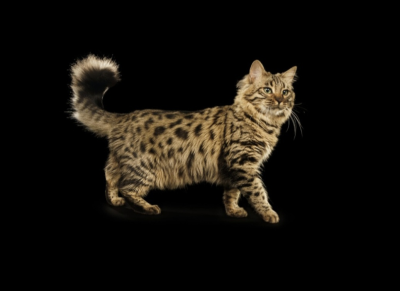 Longhair Bengal
Longhair Bengal
Bengals can mature quickly. Females may begin their reproductive cycles as early as 4.5 months old, and males can sire kittens as young as 6 months. Spaying or neutering Bengal kittens before they exhibit sexual behaviour is crucial to prevent territorial marking in males and pyometra (a uterine infection) in females.
Bengal cats are recognized in two tabby patterns: Spotted/Rosetted and Marble. These two tabby patterns can be combined with two different visual effects on the colour: Charcoal and Lynx Point (also known as Snow). At present CCA recognizes the breed in four classes: Spotted, Marble, Lynx Point, and Charcoal.
Coat Colours
- Brown Bengal: The most common and classic colour, brown Bengals range from light and warm to intense and dark, or even a cool, greyish brown. The most sought-after brown Bengals have a warm, beige, or golden-brown base coat with black or dark brown rosettes and/or spots, creating a truly wild appearance.
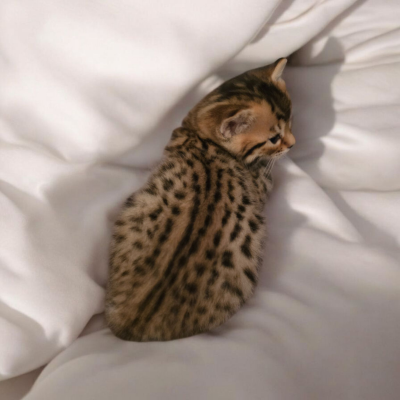
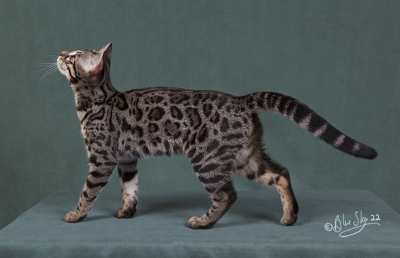 Brown Spotted Tabby Bengal Kitten | Brown Spotted Tabby Bengal Adult
Brown Spotted Tabby Bengal Kitten | Brown Spotted Tabby Bengal Adult
- Silver Bengal: Silver Bengals have a cool, silvery base coat with black or dark grey markings. This colour is relatively recent in the breed, having been introduced in 2005 to resemble snow leopards.
- Blue Bengal: A less common colour, blue Bengals are essentially a variation of silver. They feature a bluish-grey base coat with darker blue or grey markings. This colour arises from two copies of the dilution gene, which is only visibly expressed in silver Bengals.
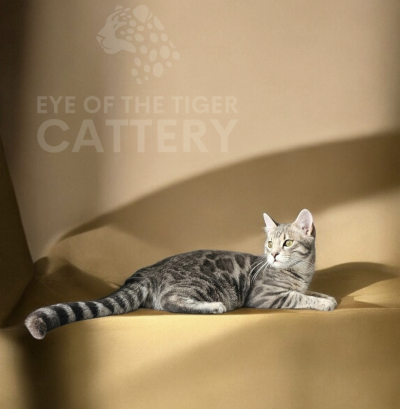 Blue Spotted Tabby Bengal
Blue Spotted Tabby Bengal
Patterns and Effects
The primary Bengal colors are paired with different pattern types and effects, for example Brown Charcoal Spotted Tabby, Seal Silver Sepia Marble Tabby, etc., allowing a wide range in the Bengal's unique look.
Spotted: This pattern resembles that of a leopard, with spots scattered across the body. The spots can be random, horizontally or diagonally aligned, or form rosettes. Rosettes are essentially spots with a darker outline. They can vary in shape and distribution, including arrowhead (pointed in one direction), fully outlined (donut-shaped), or paw print (small spots surrounding a larger spot). Randomly distributed single spots or rosettes are common, often developing to cover larger areas of the body. Large or medium-sized, irregularly shaped rosettes with minimal spacing can create the exotic "clouded" pattern, similar to that of clouded leopards. The Bengal is the only domestic cat breed that exhibits rosettes.
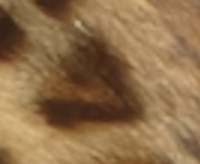
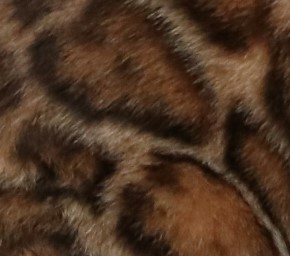
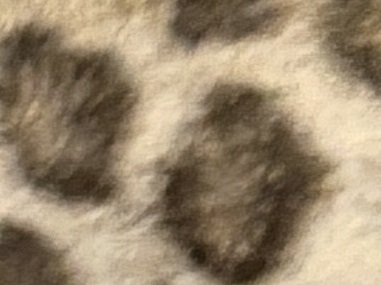
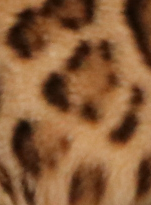 Arrow-shaped rosettes | Clouded pattern rosettes | Donut-shaped rosettes | Paw print rosettes
Arrow-shaped rosettes | Clouded pattern rosettes | Donut-shaped rosettes | Paw print rosettes
Marbled: This pattern is swirled and flowing, resembling the classic tabby pattern but with more contrast and a more exotic look. The marbling often appears as a mix of flowing lines and swirls.
Lynx Point (Snow): Snow Bengals have a lighter, warm, creamy base coat with varying shades of brown or grey markings. Born white, they develop their low-contrast spots later. In essence, any Bengal colour can become "snow" with two copies of the appropriate colourpoint gene. In CCA three types of snow colour are accepted for championship: Lynx Point, Mink and Sepia.
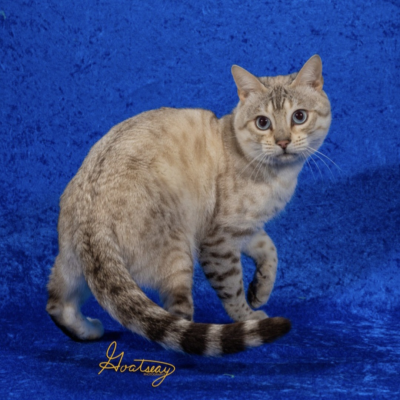
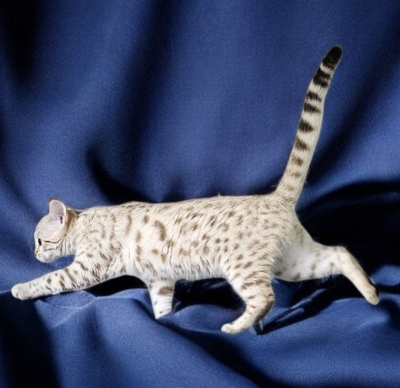 Seal Lynx Point Spotted Tabby Bengal | Seal Mink Spotted Tabby Bengal
Seal Lynx Point Spotted Tabby Bengal | Seal Mink Spotted Tabby Bengal
Charcoal Bengals: Characterized by a darker overall appearance with a smoky hue and a distinct facial mask known as “Zorro” mask: a dark nose and a very light outline around the eyes. They can have either a brown or silver base. This specific effect originally came from Asian Leopard cat, and can be visible if two copies of charcoal gene are present in cat’s DNA. Charcoal Bengals are accepted for championship in CCA. A combination of one solid and one charcoal gene also gives the charcoal pattern effect. Charcoal Bengals may have a darker appearance.
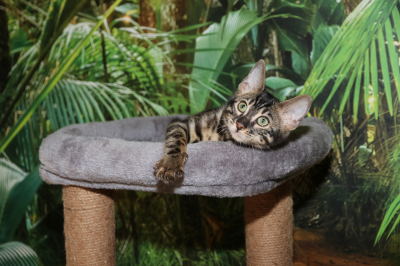
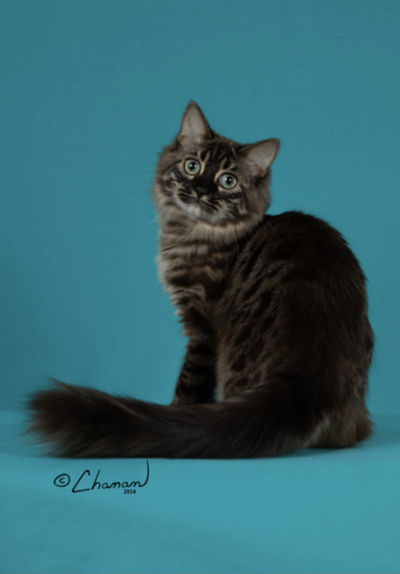 Charcoal Bengals
Charcoal Bengals
Melanistic and Smoke Bengals are accepted in the CCA in the CCA's "Any Other Variety" category. Melanistic and smoke Bengals have two copies of the solid (black) color, so every hair of the coat has more or less black color. However, the pattern is still visible due to aguti gene and two copies of the gene responsible for spots or marbling. Melanistic Bengals have a brown base color, which gives a minimum contrast with the black pattern; therefore, the pattern is of ghost type. Smoke
Bengals are also melanistic but have a silver base; therefore, the black pattern is clearly visible on the white/greyish undercoat.
For more information please see the Bengal Breed Standard.
Additional Information
- Personality: Bengals are active, intelligent, and playful cats. While known for their high energy levels and curiosity, they are no more active overall than the average domestic cat, which sleeps 15-20 hours a day. Bengals can be extremely active in the periods they do not sleep, usually 2-3 hours a day, early morning and late evening, resting during the day and night. They simply concentrate their activity into those periods. They enjoy interactive play, climbing, and exploring, making them excellent travel companions. They may seek out attention, follow their owners around the house, and even cuddle, showcasing their desire for companionship. They thrive in environments with ample space and vertical opportunities like cat trees and shelves. Bengals, especially males, can be very affectionate and friendly, even with strangers, often seeking petting and even sitting on laps. Females may be more reserved with unfamiliar people, though some can be just as affectionate as males. Early and consistent positive interactions with people are crucial for developing these affectionate traits.
- Intelligence and Training Ability: Bengals are highly intelligent cats, displaying problem-solving skills and curiosity akin to that of dogs. They can learn tricks, respond to commands, and enjoy puzzle toys that stimulate their minds. Bengals can be trained to perform various behaviors and tricks, much like dogs. They can learn to walk on a leash, or even play fetch, showcasing their trainability and willingness to please. These features make Bengals a unique blend of feline independence and canine-like attributes, appealing to pet owners who appreciate both cats and dogs.
- Social Behaviour: Bengals are generally social cats that can get along well with children and other pets, particularly dogs, when properly socialized. They form strong bonds with their human families and are often friendly with visitors. The first few weeks of a Bengal kitten's life are critical for socialization; consistent, early, and positive interactions with people are essential for developing a desirable, affectionate personality.
- Vocalizations: Bengals can be quite vocal, using a range of sounds to communicate with people, similar to some dog breeds that are known for their barking or vocal expressions. They may "talk" to their owners, expressing their needs and desires.
- Health: Bengals are generally healthy, however, like all breeds, they can be prone to certain genetic health issues, including Progressive Retinal Atrophy (PRA), Hypertrophic Cardiomyopathy (HCM), and Polycystic Kidney Disease (PKD). Responsible breeders screen their Bengals for these conditions using DNA tests to ensure healthy offspring.
- Grooming: Bengals have low grooming needs due to their short coats and minimal shedding. However, they often enjoy brushing, which can strengthen the bond with their owners and keep their coats in excellent condition.
- Many Bengals also enjoy playing with water if water fountain or splash is around. They can willingly go to the bathtub or shower.